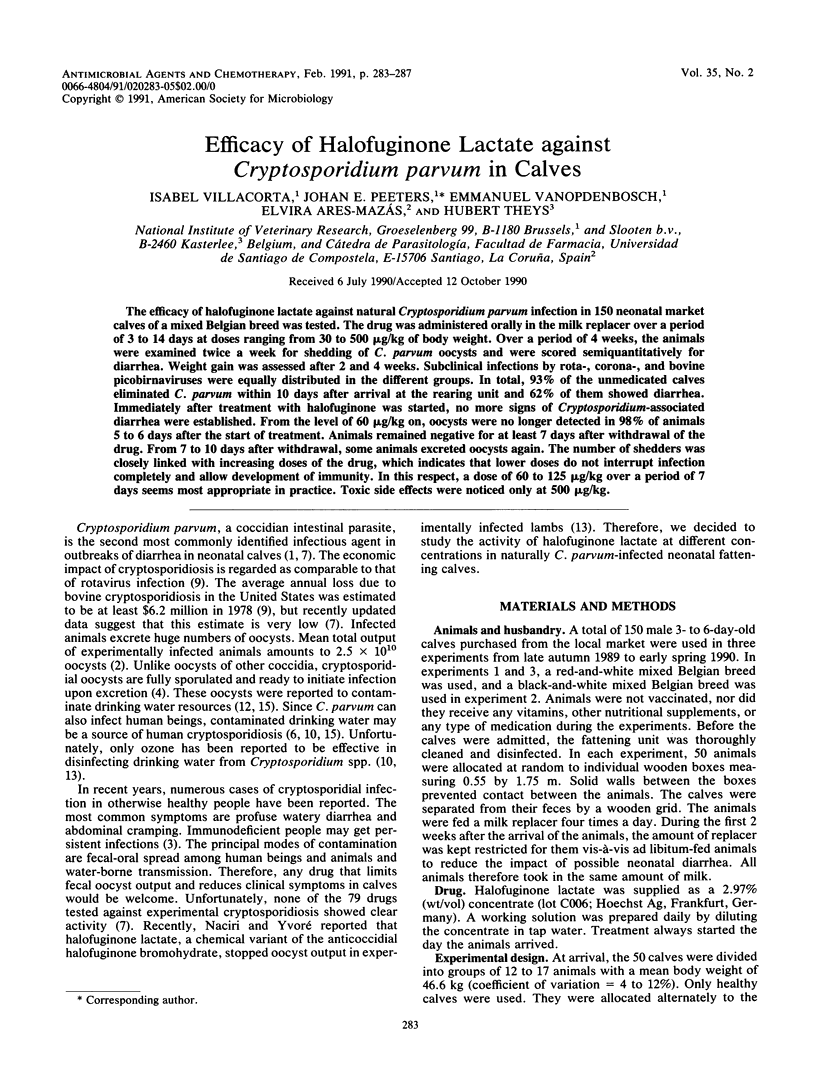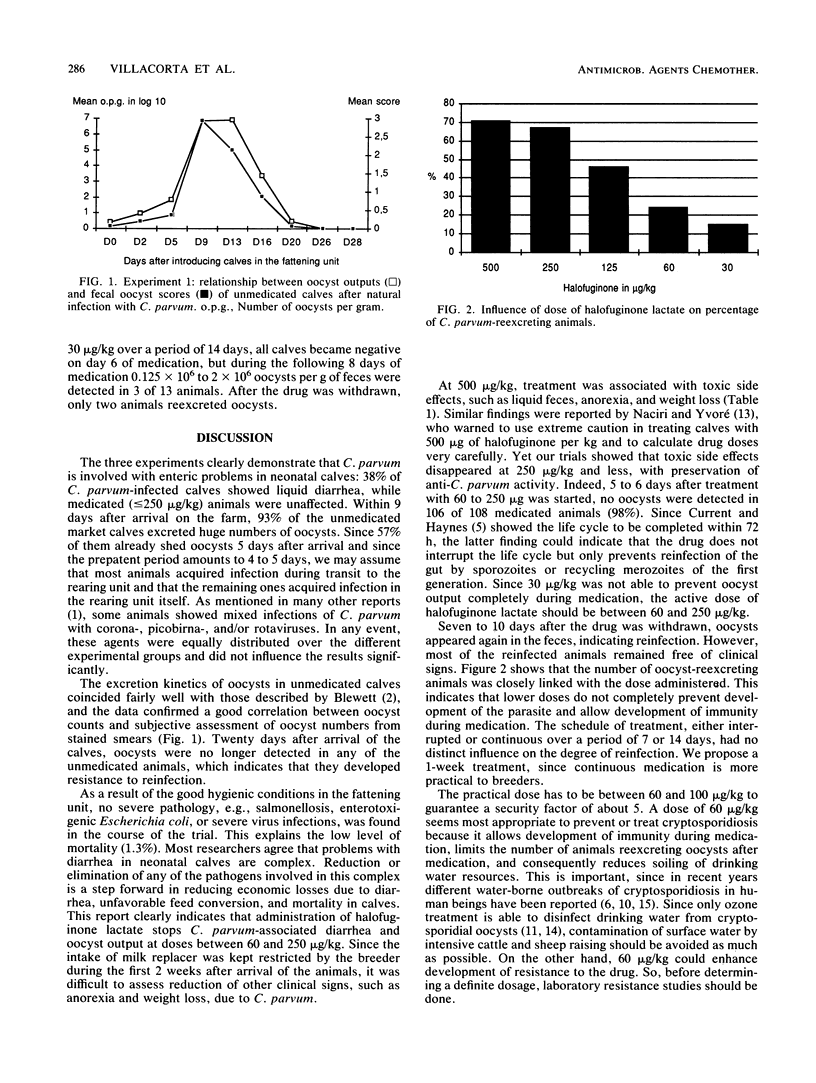Abstract
The efficacy of halofuginone lactate against natural Cryptosporidium parvum infection in 150 neonatal market calves of a mixed Belgian breed was tested. The drug was administered orally in the milk replacer over a period of 3 to 14 days at doses ranging from 30 to 500 micrograms/kg of body weight. Over a period of 4 weeks, the animals were examined twice a week for shedding of C. parvum oocysts and were scored semiquantitatively for diarrhea. Weight gain was assessed after 2 and 4 weeks. Subclinical infections by rota-, corona-, and bovine picobirnaviruses were equally distributed in the different groups. In total, 93% of the unmedicated calves eliminated C. parvum within 10 days after arrival at the rearing unit and 62% of them showed diarrhea. Immediately after treatment with halofuginone was started, no more signs of Cryptosporidium-associated diarrhea were established. From the level of 60 micrograms/kg on, oocysts were no longer detected in 98% of animals 5 to 6 days after the start of treatment. Animals remained negative for at least 7 days after withdrawal of the drug. From 7 to 10 days after withdrawal, some animals excreted oocysts again. The number of shedders was closely linked with increasing doses of the drug, which indicates that lower doses do not interrupt infection completely and allow development of immunity. In this respect, a dose of 60 to 125 micrograms/kg over a period of 7 days seems most appropriate in practice. Toxic side effects were noticed only at 500 micrograms/kg.
Full text
PDF




Selected References
These references are in PubMed. This may not be the complete list of references from this article.
- Crawford F. G., Vermund S. H. Human cryptosporidiosis. Crit Rev Microbiol. 1988;16(2):113–159. doi: 10.3109/10408418809104469. [DOI] [PubMed] [Google Scholar]
- Current W. L. Cryptosporidiosis. J Am Vet Med Assoc. 1985 Dec 15;187(12):1334–1338. [PubMed] [Google Scholar]
- Current W. L., Haynes T. B. Complete development of Cryptosporidium in cell culture. Science. 1984 May 11;224(4649):603–605. doi: 10.1126/science.6710159. [DOI] [PubMed] [Google Scholar]
- D'Antonio R. G., Winn R. E., Taylor J. P., Gustafson T. L., Current W. L., Rhodes M. M., Gary G. W., Jr, Zajac R. A. A waterborne outbreak of cryptosporidiosis in normal hosts. Ann Intern Med. 1985 Dec;103(6 ):886–888. doi: 10.7326/0003-4819-103-6-886. [DOI] [PubMed] [Google Scholar]
- Fayer R., Ungar B. L. Cryptosporidium spp. and cryptosporidiosis. Microbiol Rev. 1986 Dec;50(4):458–483. doi: 10.1128/mr.50.4.458-483.1986. [DOI] [PMC free article] [PubMed] [Google Scholar]
- Heine J. Eine einfache Nachweismethode für Kryptosporidien im Kot. Zentralbl Veterinarmed B. 1982 May;29(4):324–327. [PubMed] [Google Scholar]
- House J. A. Economic impact of rotavirus and other neonatal disease agents of animals. J Am Vet Med Assoc. 1978 Sep 1;173(5 Pt 2):573–576. [PubMed] [Google Scholar]
- Isaac-Renton J. L., Fogel D., Stibbs H. H., Ongerth J. E. Giardia and Cryptosporidium in drinking water. Lancet. 1987 Apr 25;1(8539):973–974. doi: 10.1016/s0140-6736(87)90313-8. [DOI] [PubMed] [Google Scholar]
- Korich D. G., Mead J. R., Madore M. S., Sinclair N. A., Sterling C. R. Effects of ozone, chlorine dioxide, chlorine, and monochloramine on Cryptosporidium parvum oocyst viability. Appl Environ Microbiol. 1990 May;56(5):1423–1428. doi: 10.1128/aem.56.5.1423-1428.1990. [DOI] [PMC free article] [PubMed] [Google Scholar]
- Madore M. S., Rose J. B., Gerba C. P., Arrowood M. J., Sterling C. R. Occurrence of Cryptosporidium oocysts in sewage effluents and selected surface waters. J Parasitol. 1987 Aug;73(4):702–705. [PubMed] [Google Scholar]
- Peeters J. E., Mazás E. A., Masschelein W. J., Villacorta Martiez de Maturana I., Debacker E. Effect of disinfection of drinking water with ozone or chlorine dioxide on survival of Cryptosporidium parvum oocysts. Appl Environ Microbiol. 1989 Jun;55(6):1519–1522. doi: 10.1128/aem.55.6.1519-1522.1989. [DOI] [PMC free article] [PubMed] [Google Scholar]
- Rush B. A., Chapman P. A., Ineson R. W. Cryptosporidium and drinking water. Lancet. 1987 Sep 12;2(8559):632–633. doi: 10.1016/s0140-6736(87)93029-7. [DOI] [PubMed] [Google Scholar]


